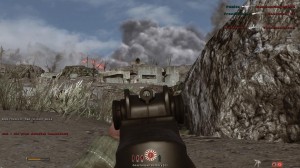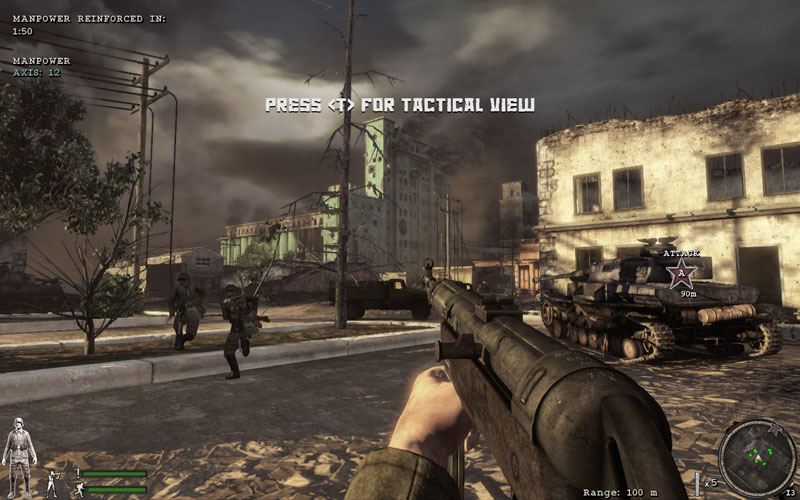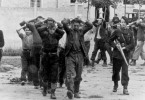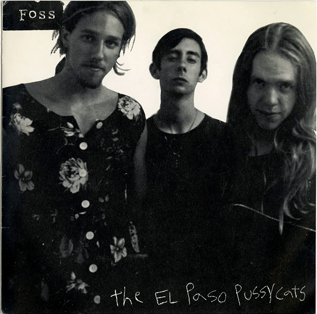aNewDomain.net — Greetings gaming comrades. Welcome to my latest epic gaming review. This time I’m looking at Red Orchestra 2 Heroes of Stalingrad. It was voted Game of the Year in 2011, but I’ll be the judge of that.

Image credit: Tripwire Interactive
I was new to the Red Orchestra series until recently, but when I saw it was free off Steam, I decided to give it a try. And I found out, as first-person shooters go — and that’s what Red Orchestra is — this is a seriously challenging game. I found it much more difficult than, say, Call of Duty. But don’t let that get you down. If you love FPS action as much as I do, you definitely want to take a closer look at Red Orchestra 2 Heroes of Stalingrad. In-depth review below.
The Campaign
In Red Orchestra 2, you’re right in the Battle of Stalingrad. German and Soviet campaigns are available and playable, but the Soviet campaign is not accessible until the German one is complete. (SPOILER ALERT: the Soviets win.)
Personally, I find games that allow the player to experience both sides of battle to be way more enjoyable. So many games are predictable — allies are the good guys, axis are evil — and Red Orchestra 2 really changes that up.
The player moves through a historically-based battle in extremely high detail, which of course makes me feel like an actual soldier fighting for a cause. The German campaign ends at a cliffhanger, while the Soviet campaign brings the battle to an end, providing closure to the story.

Image credit: Tripwire Interactive
The narration in Red Orchestra 2 really sets the mood as the player heads out to either crush the forces of Bolshevism or destroy the Fascist beast. The diction, the voice acting and the accents are portrayed perfectly. And it’s a good thing the whole experience feels authentic because, as I said at the outset, the campaign itself is so hard. You’ll be hearing those clips over and over.
The difficulty is real, comrades. To be honest, Call of Duty on veteran was equal to Red Orchestra 2 on rookie (though it was just like a normal FPS on multiplayer).
Basically, the player either attacks or defends a series of objectives to achieve victory — essentially a bloody version of king of the hill. The player isn’t some overpowered buff guy wrecking his way through the whole place, only to escape in a random helicopter. Nope, you’re stuck in the hell that is Stalingrad.
Make sure to get in under cover too, because if you’re ever out in the open: lights out. At this point you’re probably thinking, this game is so hard, how do people even survive? To which I reply, “Welcome to Stalingrad, 1942.” I won’t recommend this game to rookies. You’ll rage and quit faster than a German would get sniped in the actual battle. But it’s a fun challenge for experienced FPS players.
The Graphics
Now, unfortunately, the graphics aren’t as good as the campaign. The graphics look cheap and outdated (and in 2014, they actually are to some degree). Red Orchestra 2 just doesn’t have anywhere close to the high detail most other FPS games offer, even those a couple of years old. Also, the frame rate was too slow. Graphics-wise, I experienced many bugs and glitches, up to and including freeze frames and goofy, unnatural movements by the AI.

Image credit: Tripwire Interactive
The whole graphics thing makes you (well, me) want to get up and shake the developers over at Tripwire Interactive. Yes, the game concept and storyline are excellent. But it feels like the game itself is in alpha — at least in the pre-release I looked at. It’s so frustrating having your computer freeze and crash any time you’re on an epic kill streak. Although dying streaks are the only common occurrence in this game.
Still, I do have to admire the sheer amount of physics they put into the game, using principles such as ballistics drops to increase the sense of realism. Trying to aim sometimes gets frustrating, like sniping in Battlefield 4. I think this is only a matter of deadline rush, where non-ready games are pushed out on the market, essentially in its beta version. You should’ve taken your time, Tripwire. This could have been a perfect game.
Multiplayer

Image credit: Tripwire Interactive
Finally, the multiplayer mode in the game is basically an online version of single-player. Not a bad thing, just not hugely unique. Plus, Tripwire Interactive combined my version of the game with the expansion pack Rising Storm, allowing the player to play as the Japanese or Americans as well as the classic Germans or Soviets.
The multiplayer is a good concept, but it’s still riddled with serious AI glitches. For instance, I’ve seen all my allies gather in one spot and just stand there, while I go straight to the objective and get massacred. Plus, my map has turned into the weirdest colors at times — just unexplainable glitches.
I will commend Tripwire for its details, large amount of classes and the promotion of teamwork in the multiplayer mode, a step above noob attackers or campers, like in Call of Duty. (On that topic, 12 year old boys, don’t try this multiplayer. We veterans don’t want to hear you rage and quit in the first two seconds of the game.)
Overall I’ll have to give Red Orchestra 2 Heroes of Stalingrad a 7/10. I liked the concept, and the historical campaign was one of the best I’ve ever seen. This game has details about the battle that I’ve never seen in any history books or documentaries before. Yet the bad graphics and all the technical glitches make Red Orchestra 2 feel like a classic beta that still needs to go back to the company for testing. Still, good job Tripwire Interactive, good job.
Until next time this is Fegelein Puching Zhang signing off for aNewDomain.net.
Based in Chicago, Fegelein Puching Zhang is our gaming scribe at aNewDomain.net. Read more of his work here or contact him at puching@anewdomain.net.














[…] five-to-six hits is all it takes for a tank to be destroyed. Thus gameplay is more like that of Red Orchestra, where players strategize and gain advantage through superior position rather than classic Call of […]